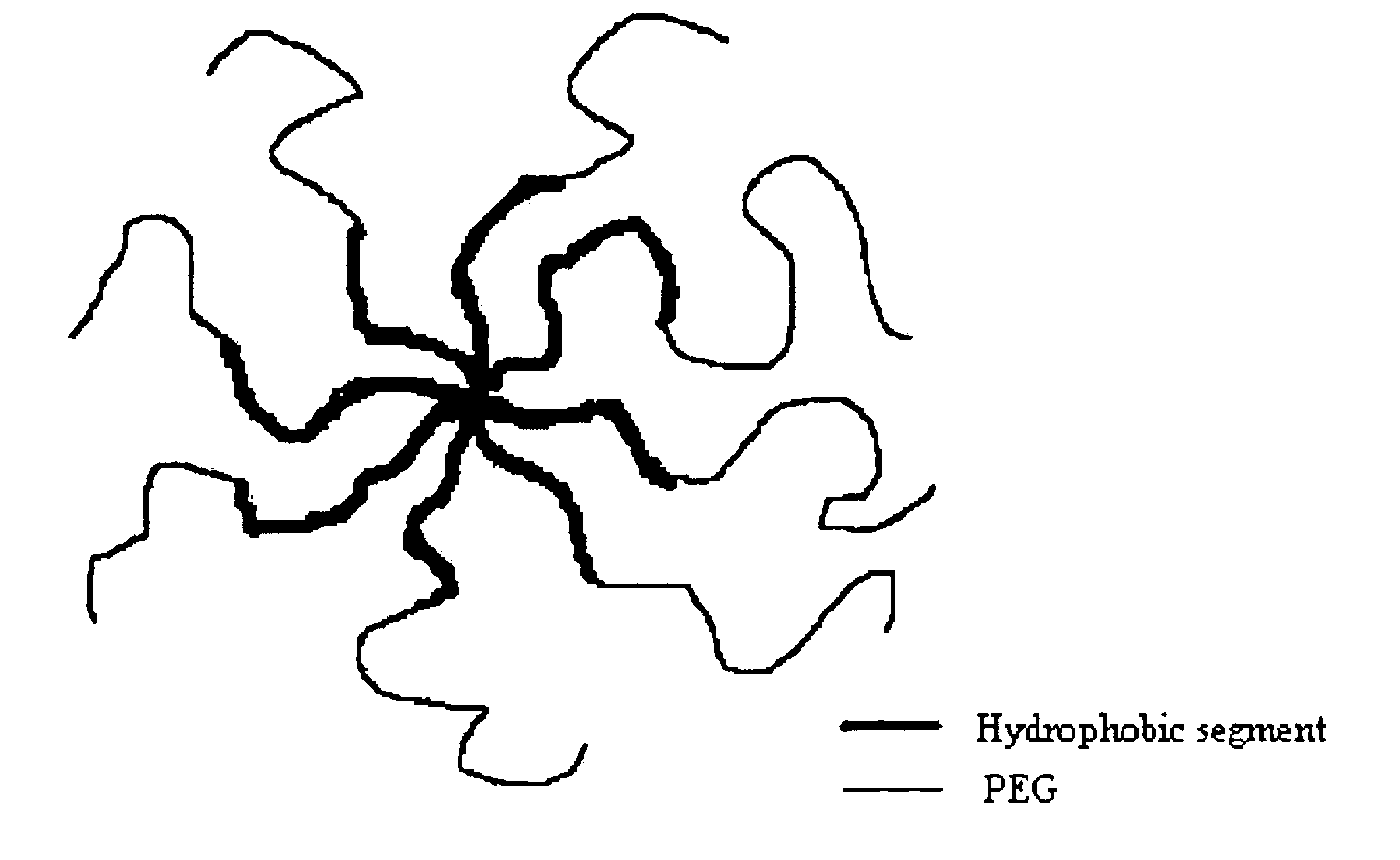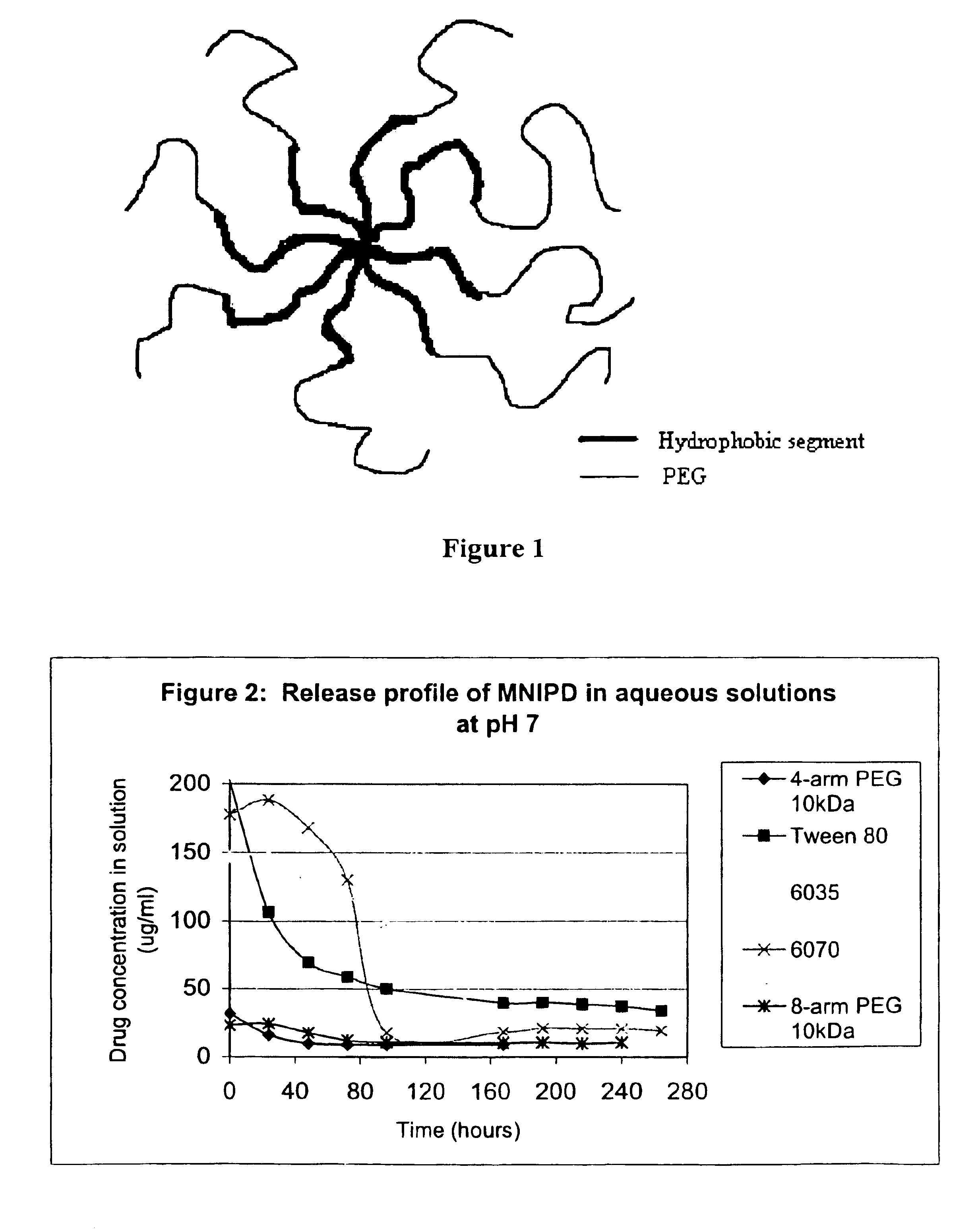Multi-arm block copolymers as drug delivery vehicles
a technology of copolymer and drug delivery, which is applied in the field of multi-arm copolymer, can solve the problems of rapid drug release, severe allergic reactions and hypersensitivity of surfactants, and conventional surfactant-based carriers lack the ability to provide controlled drug release, so as to improve the solubility of hydrophobic biologically active agents and improve the delivery of hydrophobic drugs
- Summary
- Abstract
- Description
- Claims
- Application Information
AI Technical Summary
Benefits of technology
Problems solved by technology
Method used
Image
Examples
third embodiment
In a third embodiment, the copolymer has the following structure represented by Formula IV:
(T—C—O—B—O—)pA(—O—B—O—C—D)m
wherein:A, O, B, C are as described above,D is a capping group,p is at least 1,the sum of m and p is from 3 to about 25, andT is a targeting moiety or drug moiety as described above, such as a bisphosphonate.
Regarding Formulas III and IV above, in one embodiment, p is 1 to about 5, preferably 1 to about 3, and the sum of m and p is about 6 to about 21, preferably about 8 to about 15.
Formula V below is an exemplary 8-arm PPO—PEG block copolymer made in accordance with the invention:
Formula VI below is an exemplary 8-arm degradable poly(lactide)-poly(ethylene glycol) (PLA—PEG) block copolymer of the invention:
E. The Hydrophobic Drug
The hydrophobic biologically active moiety or drug may be any biologically active hydrophobic compound that would benefit from increased aqueous solubility. The entrapped or encapsulated drug may be utilized per se or in the form of a phar...
example 1
Preparation of 8-arm Polylactide-mPEG5kDa (8-arm-PLA—mPEG5kDa)
In a 250 mL three neck round bottom flask, hexaglycerol (4.307 gm, 0.008 moles (Sakamoto Yakuhin Kogyo Co., Ltd., Osaka, Japan) was heated at 100° C. for one hour under vacuum (1 mmHg). The contents were cooled to ambient temperature and placed under argon. DL-lactide (160 gm, 1.110 moles (Purasorb, Purac, Holland) was added and the flask flushed with argon then heated at 150° C. Stannous 2-ethyhexaneoate (94.6 mg, 2.22×10−4 moles) was added and the mixture heated under argon at 170° C. for twenty-four hours. The mixture was cooled to 160° C. and stirred under vacuum (less than 1 mm Hg) for three hours. After cooling to room temperature the mixture was dissolved in dichloromethane (900 mL). The solution was concentrated to near dryness at reduced pressure and poured into hexanes (1500 mL) with stirring to precipitate. The supernatant was decanted and the residue dried under vacuum. NMR (CDCl3): δ 5.16 (m, —OCH(—CH3)CO—), ...
example 2
Preparation of 8-arm Polylactide PEG26kDa (8-arm-PLA—PEG26kDa)
8-arm-polylactide (8-arm-PLA) (3.00 g, Mw˜20 kDa), branched PEG carboxylic acid (PEG2—COOH, 6kDa, 7 g), DMAP (120 mg), HOBT (105 mg) and DCC (440 mg) were dissolved in methylene chloride (50 ml). The reaction was stirred at room temperature for about 72 hours. The solvent was then removed under vacuum, and 35 ml of 1,4 dioxane was added to the syrup. After filtering, the filtrate was added to 200 ml of diethyl ether. The precipitate was collected by filtration, washed with isopropyl alcohol (IPA) and ether, and then dried overnight under vacuum. Yield: 9.4 g. 1H NMR(DMSO-d6): δ 3.5 (br m, PEG), 1.45 (d, —OCCH(CH3)O—), 5.165 (m, OCCH(CH3)O—), 4.03 (t, mPEGOCH2CH2OCONH—).
PUM
| Property | Measurement | Unit |
|---|---|---|
| molecular weight | aaaaa | aaaaa |
| molecular weight | aaaaa | aaaaa |
| molecular weight | aaaaa | aaaaa |
Abstract
Description
Claims
Application Information
 Login to View More
Login to View More - R&D
- Intellectual Property
- Life Sciences
- Materials
- Tech Scout
- Unparalleled Data Quality
- Higher Quality Content
- 60% Fewer Hallucinations
Browse by: Latest US Patents, China's latest patents, Technical Efficacy Thesaurus, Application Domain, Technology Topic, Popular Technical Reports.
© 2025 PatSnap. All rights reserved.Legal|Privacy policy|Modern Slavery Act Transparency Statement|Sitemap|About US| Contact US: help@patsnap.com



